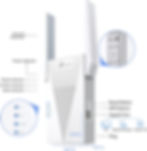WiFi Repeater Setup: How to Set Up and Connect a WiFi Repeater
- CaTessa Jones
- Dec 17, 2024
- 2 min read
A WiFi repeater is a cost-effective solution to extend your wireless network's range, ensuring strong connectivity in hard-to-reach areas of your home or office. Setting up a WiFi repeater is a straightforward process that can significantly enhance your internet experience. Here’s a step-by-step guide to help you set up and connect a WiFi repeater.
What Is a WiFi Repeater?
A WiFi repeater amplifies your existing wireless signal and rebroadcasts it, creating a secondary network. By placing it strategically between your router and the area with poor coverage, you can boost connectivity without needing additional wiring or expensive equipment.

Step 1: Select the Right Location
The location of your WiFi repeater is crucial for optimal performance.
Place it halfway between your router and the dead zone where the signal is weak.
Ensure it’s within the range of your existing WiFi signal.
Avoid placing it near walls, metal objects, or electronic devices that could cause interference.
Step 2: Plug in the Repeater
Plug the repeater into a power outlet near your router for the initial setup.
Turn it on and wait for the indicator light to stabilize (check the manual for specific light codes).
Step 3: Connect to the Repeater
Option A: Using WPS (Wi-Fi Protected Setup)
Press the WPS button on your router.
Within two minutes, press the WPS button on the repeater.
The repeater will automatically connect to the router. You’ll typically see a confirmation light.
Option B: Using a Web Interface
Connect your device (phone, tablet, or laptop) to the repeater’s default WiFi network (check the manual for SSID and password).
Open a web browser and enter the repeater’s IP address (commonly 192.168.0.1 or 192.168.1.1).
Log in with the default username and password (usually printed on the repeater or in the manual).
Follow the on-screen instructions to connect the repeater to your WiFi network:
Select your home WiFi network from the list.
Enter your WiFi password.
Save the settings and allow the repeater to reboot.
Step 4: Test the Connection
Move the repeater to the desired location.
Ensure the signal indicator (if available) shows a strong connection.
Connect your devices to the repeater’s network, which may have the same name as your original network or a variation (e.g., “NetworkName_EXT”).
Step 5: Fine-Tune for Optimal Performance
Check Signal Strength: Use your device’s WiFi signal strength indicator to ensure the repeater is effectively boosting the signal.
Adjust Placement: If necessary, reposition the repeater for better coverage.
Avoid Overlapping Channels: Ensure the repeater and router are on non-overlapping channels to minimize interference (this can be adjusted in the repeater’s settings).
Troubleshooting Common Issues
No Internet Access: Double-check the WiFi password entered during setup.
Weak Signal: Move the repeater closer to the router.
Connection Drops: Ensure the repeater firmware is updated to the latest version.
Cannot Access Setup Page: Reset the repeater by holding down the reset button for 10 seconds and try again.
Conclusion
Setting up a WiFi repeater is a simple yet effective way to extend your internet coverage and eliminate dead zones. By carefully selecting the location and following the setup process, you can enjoy seamless connectivity across your home or office.

